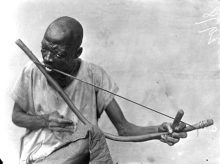Mouth arch

The mouth bow is a simple stringed instrument , which consists of one or rarely up to three strings, which are stretched on a flexible string support, usually a curved wooden stick. A mouth bow is a special form of musical bow in which the player uses his oral cavity to amplify and modulate the sound like a jew's harp.
For the worldwide spread of the mouth bow see the article music bow .
Design and style of play
By the type of sound amplification music sheets are divided into two groups: those with at least one laterally attached resonance body , often a gourd where the chord or chords carrier at a particular location on or in the mouth is held and mouth sheets. The instrument type, which is extremely simple in terms of its construction, offers various possibilities to set the string vibrating and can thus generate a wide range of sounds. The string can be plucked with the fingers, struck with a stick and stroked with a rubbing stick or bow. By deforming the mouth and cheeks, individual partials can be filtered out from the overtones lying above the fundamental tone of the string and amplified in order to change the pitch and sound. If the string is retightened by hand, the result is a higher keynote, which is why the knot with which the string is attached can usually be easily loosened at one end. With some mouth bows, the string is shortened while playing by touching the side with the finger in order to produce a higher keynote.
An approximately 15,000 year old cave drawing in the Three Brothers Cave in France shows a dancer playing the mouth bow. Mouth bows existed in ancient Greece , they were the forerunners of the Indian string instruments and they accompanied the shamans at their meetings in Japan. Mouth arches were and are most widespread in sub- Saharan Africa . There they are known to the Bantu-speaking population, their focus is on the Khoisan speakers in southern Africa. Mouth bows (musical bows) do not differ in principle from hunting bows, the same instrument can be used in both functions.
In many African mouth bows, a tuning loop placed slightly off the middle divides the string into two parts, so that two tones can be played, which usually differ in height by about a whole tone. The different ways of playing are related to the position of the mouth:
The mouth bow used as a hunting bow ohonji (also onkhonji ) of !Kung in the south of Angola is plugged at one end in his mouth. The approximately one meter long rod presses against the right cheek from the inside and is held with its free end pointing downwards to the left, with the left hand gripping the rod approximately in its middle. The player strikes the string with a stick in his right hand. The tone is very deep. The fifth to sixth partial tone can be amplified by changing the oral cavity.
Another mouth arch in this region, called sagaya , is touched with the mouth in the middle of the arch. The upper lip presses firmly against the stick, the lower lip moves while playing, as if the musician was speaking. The !Kung complement the string tone often by additional, brought forth by mouth noise sounds.
In the mtyangala mouth arch , which is only played by the women of the Tumbuka in Malawi and is plucked with a plectrum, the undivided string runs over an almost straight rod from a plant tube. This type of mouth bow originally belongs to the tradition of the Nguni ethnic groups in South Africa, where a corresponding mouth bow is called umqangala . The lekope, which is only played by men in the South African pedi, belongs to a special type of mouth bow, which consists of a three-part string support with a thicker center piece and whose string is divided by a tuning loop.
Xhosa women in South Africa play the umrhubhe by stroking the string with a rubbing stick. An increased by mouth Schrapbogen, where the player strokes with a rod on the ribbed side of the string carrier is the xizambi of Tsonga . In South Africa the single-stringed zither tshidzholo , which was also strengthened with the mouth , existed until the middle of the 20th century .
See also
- Pluriarc , a multi-string musical bow with several strings
Web links
Individual evidence
- ^ Gerhard Kubik : The Khoisan legacy in the south of Angola. In: Erich Stockmann (Ed.): Music cultures in Africa. Verlag Neue Musik, Berlin (GDR) 1987, pp. 100–110
